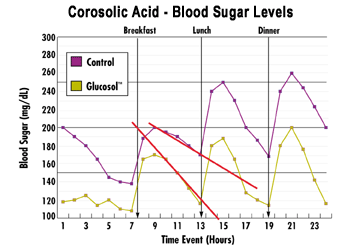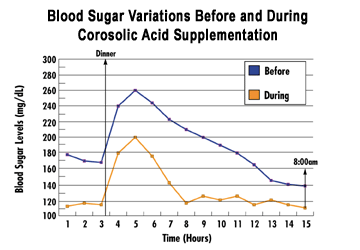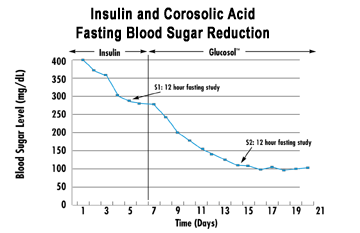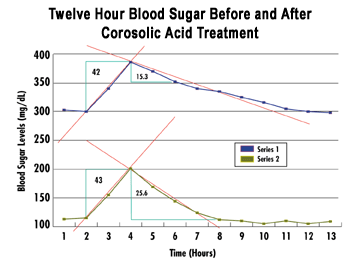Life Extension Magazine®
Diabetes affects 16 million people in the United States and is the fourth leading cause of death. Diabetes is also the principal cause of blindness in adults and is the most common cause of kidney failure. Neuropathy, artery disease and premature aging are common conditions associated with chronically elevated blood sugar levels.
Type I Diabetes, often called juvenile diabetes, is insulin dependent and affects only 5% of the diabetic population. Type II Diabetes, or non-insulin dependent diabetes, usually develops in adults over the age of 40. In recent years, there has been an increase in the incidence of Type II diabetes.
People with Type II diabetes often show no symptoms. Type II diabetes occurs as a result of the decline in cell membrane insulin sensitivity that can be aggravated by the consumption of high-glycemic carbohydrates, obesity, lack of exercise and the aging process.
Various medicinal plants from India, China and Japan are used for the treatment of diabetes. The most effective plant constituent appears to be corosolic acid, which can be found in the leaves of the Lagestroemia Speciosa L tree.
Cell glucose uptake
Dr. Yamazaki, professor of Pharmaceutical Science, Hiroshima University School of Medicine, Japan, studied the effects of corosolic acid in relation to its insulin-like properties. His studies indicate that corosolic acid activates the transport of glucose across cell membranes, resulting in blood sugar reductions. Insulin is the hormone that naturally increases glucose transport activity across cell membranes. In the Type II diabetic, cell membranes are often less responsive to insulin-induced glucose uptake.
Oral administration of insulin does not reduce blood sugar, whereas orally administered corosolic acid can produce a drop in blood sugar levels. Large doses of injected insulin are capable of producing adverse reactions, while oral doses of corosolic acid have no known side effects. In rabbits, oral doses of corosolic acid have been shown to act similarly to subcutaneous injections of insulin. Hence, corosolic acid may be defined as a phyto-insulin or insulin-like plant extract.
Corosolic Acid - Blood Sugar Levels
 |
Hourly blood sugar levels in Type II Diabetic patients before and after 30 days of 48 mg/day corosolic acid supplementation. Note the apparent steeper decline and the lower minimal blood sugar level during corosolic acid supplementation compared to the control study. These differences (20 vs 11 mg/dL/hour) between corosolic acid and the control conditions shows that the rate of sugar transport during corosolic acid supplementation is twice that for the control condition.
Preclinical studies
Glucose transport is the most important way that cells acquire energy. An increase of glucose transport through the cell membrane facilitates the lowering of blood sugar. Therefore, finding a safe activator of glucose transport is crucial to the Type II diabetic. Ehrlich ascites tumor cells are useful for screening the glucose transport potential of natural products. In one study, the time course of glucose uptake by Ehrlich cells was measured and corosolic acid showed significant glucose transport-stimulating activity.
The sugar-lowering effects of corosolic acid were then studied in hereditary Type II diabetic mice. In the first experiment, one group of mice was fed a control diet while the other group was given a diet that included corosolic acid for a period of five weeks. The plasma glucose levels increased in the control group, but this increase was completely suppressed in the mice given corosolic acid. In this experiment, crossover of the diet between the two groups yielded results consistent with the above observation.
In a second experiment on Type II diabetic rats, supplementation with corosolic acid resulted in a decrease in glucose levels whereas the control group showed an elevation of blood sugar levels. The level of serum insulin, urinary excreted glucose and total plasma cholesterol were also lowered in mice supplemented with corosolic acid.
In another study using normal rabbits, a baseline analysis of initial blood sugar in 24 hour-fasted rabbits was conducted. Following administration of corosolic acid, blood glucose was analyzed at one, two, three, four and five hours. The results indicated that a large oral dose of corosolic acid produced blood sugar reductions similar to the effects of two units of insulin. Large doses of corosolic acid caused a more than 57 mg blood sugar reduction per 100 mL blood. Oral administration of corosolic acid reduced blood sugar in normal rabbits in amounts ranging from 16 to 49 mg per 100 mL blood. A repetition of the first dose after two more hours caused the blood sugar to remain low (or go even lower than the first dose) for more than 5 hours. Larger doses of corosolic acid caused a 40 to 58 mg blood glucose reduction per 100 mL blood. The peak reduction, after large doses, occurred from two to four hours after the administration of corosolic acid, and the blood sugar returned to normal in 6 to 10 hours. Thus, significant and immediate blood sugar reduction was observed in response to varying doses of corosolic acid.
In 1991, researchers at an Italian university observed that an oral dose of corosolic acid reduces blood sugar levels in mice. Similarly, Dr. K. Osawa at Tohoku University, Japan reported that corosolic acid reduced blood sugar levels from 300 mg per dL to 150 mg per dL in rats with experimentally induced diabetes. This study showed that corosolic acid induces a blood glucose lowering effect as immediate as an injection of insulin!
Blood Sugar Variations Before and During Corosolic Acid Supplementation
 |
Hourly blood sugar levels in a Type II Diabetic patient before and during (30 days) corosolic acid supplementation. Note the similar rise in blood sugar after the evening meal, but the slow decline in blood sugar before, compared to that during corosolic acid supplementation. The fifteen hour data points are the fasting glucose levels. The blood sugar profile during corosolic acid is more representative of that found in normal sugar regulation, whereas the slow sugar decrease after a meal is the characteristic of a Type II Diabetic.
The first human study
In 1998, a crossover, placebo-controlled clinical study was conducted at the Tokyo Jikeikai Medical School in Japan with 24 human subjects. The criteria for including the subjects in this study were a mild case of Type II diabetes, inability to tolerate a high glucose burden, glucose levels of 100 mg per dL (fasting level) and subjects older than 20 years of age. The subjects were given orally either a placebo or a standardized corosolic acid tablet after each meal three times daily. The results of this study clearly demonstrate that corosolic acid is effective in reducing blood glucose levels in short-term (four weeks) treatment, with no signs of adverse effects. Furthermore, even a one-time dose leaves a “memory-effect” for blood glucose control, for a few days. Compared to the placebo group, a statistically significant drop in the average blood glucose level is observed with the administration of corosolic acid.
Insulin and Corosolic Acid Fasting Blood Sugar Reduction
 |
Fasting blood sugar levels during seven days of insulin (300 IU x 2/day) followed by 15 days of corosolic acid (48 mg/day). Note the plateau of blood sugar at 280 mg/dL between days 4 and 7 of insulin treatment, and the plateau at 110 mg/dL after 7 days of corosolic acid treatment.
The second human study
In 1999, a clinical study was conducted by Dr. William V. Judy at the Southwestern Institute of Biomedical Research, Brandenton, Florida, to confirm corosolic acids’ effect in lowering blood glucose levels and to evaluate the dose-response relationship.
The randomized, double-blind, cross over trial was conducted with 12 subjects (6 women and 6 men) over 22 weeks. The criteria for including subjects in this study were mild Type II diabetes, inability to tolerate a high glucose burden, glucose levels of more than 150 mg/deciliter (fasting level) and subjects older than 46 years of age with an informed consent. The clinical reference value of normal blood glucose ranges from 65 to 110 mg/deciliter.
Corosolic acid, in an oil based soft gelatin capsule, was given to each group of people at the dose of 16, 32 or 48 mg per day for two weeks. The average blood glucose level dropped 4.9% at 16 mg, while the decrease was 10.7% at 32 mg , and a drop of 31.9% was noted at 48 mg per day of corosolic acid.
The second group of five people was given corosolic acid, formulated in a dry powder base, in two-piece hard gelatin capsule, at 16, 32 or 48 mg corosolic acid per day. In this group, compared to the placebo, the average blood glucose level dropped by 3.18% at 16 mg, 6.5% at 32 mg, and 20.2% at a 48 mg daily dose of corosolic acid.
These results indicate that the higher the daily dose of corosolic acid, the greater the drop in blood glucose levels. Furthermore, an oil-based soft gelatin capsule formulation of corosolic acid seems to be more potent than a comparable dry-powder formulation over the same dose range. These results suggest differences in absorption with significantly greater blood glucose reduction at a 48 mg daily dose of corosolic acid, in an oil-based soft gelatin formulation.
The subjects were monitored for various parameters: blood glucose, blood pressure, body weight, temperature, heart rate and general health and comfort in response to the supplement. Patient feed back was also noted.
Twelve Hour Blood Sugar Before and After Corosolic Acid Treatment
 |
Twelve hour blood sugar levels before and after an evening meal (600 calories) in a Type II Diabetic patient. Series 1 is before corosolic acid treatment and Series 2 is the 14 days of corosolic acid treatment. The 42 and 43 represent the amount of sugar (mg/dL/hr) absorbed in Series 1 and 2 respectively two hours after a 600 calorie evening meal. There appears to be no sugar absorption differences before or during corosolic acid treatment. The 15.3 and 25.6 before and during corosolic acid treatment represents the rate of sugar transport (mg/dL/hr) from the blood to the cell. These data show that corosolic acid enhances sugar transport by 67%. More sugar is transported during than before corosolic acid in this patient.
In the cross-over study, a group of 12 subjects was given a placebo for two weeks and their fasting blood glucose levels was monitored. The same group was given an oral daily dose of 48 mg corosolic acid (two capsules of 8 mg corosolic acid after each meal or a total of six capsules a day), in an oil-based soft gelatin formulation, for a period of 30 days. A (placebo) washout period of 45 days followed. After the washout period, the same group was crossed over to a daily 48 mg corosolic acid treatment (two capsules of 8 mg corosolic acid after each meal or a total of 6 capsules a day), in dry powder hard gelatin formulation, for a period of 30 days.
After the hard gelatin corosolic acid treatment, a second washout period of 45 days followed. The blood glucose levels were monitored at 15-day intervals, during the dosing and washout periods.
The results of this cross-over study demonstrate that an oral dose of corosolic acid is effective in reducing blood glucose levels, with no signs of adverse effects. The average blood glucose level in the control group was 168.3 mg/deciliter. The soft gelatin formulation of corosolic acid caused a rapid drop to an average value of 127.2 and 115.1 mg/deciliter at the 15th and 30th day of corosolic acid treatment, respectively. During the washout period, the recovery of the blood glucose level was slow (131.7, 153.2 and 168.2 mg/deciliter at 15, 30 and 45 days of the washout period). The washout period blood glucose levels suggest a memory effect of corosolic acid for up to four weeks, after the termination of the treatment.
These results indicate that 48 mg of corosolic acid per day shows a continued blood glucose reduction until the end of the 30-day period. Corosolic acid supplementation seems to help in regaining blood glucose control in adult onset diabetes (Type II) compared to no treatment in the control phase. Steeper decline in blood glucose levels and maintenance of lower blood glucose levels are evident in corosolic acid supplementation compared to control conditions.

Lagestroemia Speciosa L tree, showed a
significant glucose transport-stimulating
activity, at a concentration of 1 mM.
Furthermore, corosolic acid treatment causes a sharper decline in blood glucose levels after a meal, resembling a normoglycemic profile, compared to the slow decline after a meal observed in (diabetic) untreated control conditions. Subjects under corosolic acid supplementation report the disappearance of conditions associated with adult onset diabetes, such as frequent thirst and urination.
Subjects receiving the oil-based corosolic acid formulation in a soft gelatin capsule seem to show an increased tendency toward weight loss (an average weight loss of 3.2 pounds), compared to those on the dry-powder based corosolic acid formulation (no weight loss).
Corosolic acid is clinically proven to activate cell glucose-transporter “shuttles” and thus helps balance blood glucose levels. Corosolic acid shows a memory effect of blood glucose lowering even after the treatment is stopped. An oil-based corosolic acid formulation in a soft gelatin capsule seems to be relatively more efficient in lowering blood glucose levels, perhaps through increased absorption from the gut into the bloodstream.
These latest U.S. clinical study results confirm the 1998 Japanese clinical study showing that corosolic acid safely and effectively lowers blood glucose levels in Type II diabetics.
Corosolic acid also delivers a strong antioxidant activity to scavenge free radicals and to prevent cell membrane lipid peroxidation. In addition, corosolic acid helps maintain low blood pressure and normal kidney function, by controlling blood sugar, and thus preventing damage to blood vessels and kidneys.
Conclusion
Corosolic acid is a time-tested traditional medicinal plant in Asia. The leaf tea or the extract has been used for centuries as an aid for weight loss and blood sugar control, as well as a treatment for mouth ulcers and abdominal pain. Future studies are underway to measure corosolic acid’s antioxidant effects, as well as its ability to lower blood pressure, aid kidney function and to protect against the toxic glycosylation effect that occurs in response to elevated serum glucose.
